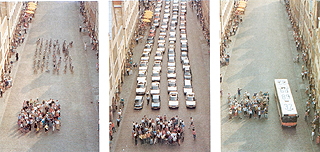|
Subscribe / Renew |
|
|
Contact Us |
|
| ► Subscribe to our Free Weekly Newsletter | |
| home | Welcome, sign in or click here to subscribe. | login |
Environment
| |
 |
September 2, 2010
Traveling the road to sustainability
DKS Associates

Meier
|
No matter what areas of your life you are seeking to make more sustainable, transportation habits are a great place to start. Without forgoing your car altogether, small changes in your travel choices can benefit both yourself and the region: from balancing the family budget to balancing our impact on the atmosphere, from the limberness of your joints to the pleasantness of our neighborhoods.
Seattle has a lusciously diverse set of transportation options that allow residents to reduce their carbon emissions, add a dose of physical activity into short trips, and connect with neighbors. As you choose your own path to living sustainability in our green city, try transit!
Lighten your carbon footprint
Trim CO2 from a commute by taking advantage of a more carbon-footprint-friendly option over the single-occupancy vehicle a few days a week. Bus, train and carpool transit, even those modes which burn fossil fuels for energy, offer improved sustainability by increasing the number of passengers per vehicle. Additionally, walking and biking burn caloric energy, increasing the number of pizza slices you can enjoy this weekend.
How much can an alternative commute lighten a coal-black carbon footprint?
Transsolutions.org encourages: “Based on an average commute distance of 30 miles roundtrip and 1 pound of CO2 produced for every mile you drive, in a year you can prevent the release of more than 1,500 pounds of CO2” by shifting away from single-occupancy vehicles.
For more on the carbon costs of transportation check out the discussions in The New York Times and the Denver Post: http://green.blogs.nytimes.com/2009/08/12/how-green-is-rail-travel/ and http://www.denverpost.com/opinion/ci_13162972.
Happy hour for the heart
The graphs of global climate change can seem out of scale with daily concerns like getting to work or taking the kids out on Saturday. The more personal charts of weight and blood pressure numbers might be more motivation to investigate some of Seattle’s non-auto options.
Adding a walk or bike to a commute is an accessible, sustainable way to increase your daily activity, perhaps working towards the Surgeon General’s recommendation of 30 minutes of activity most days of the week. Biking from home to a bus stop or getting off the train a stop or two early and walking the rest of the way could add 20 minutes of heart-healthy activity without radically disrupting your daily routine.
Also consider ways your travel habits could improve your mental health. Relinquishing the wheel a few days a week to a bus driver or fellow carpool member, taking the light rail to the stadium or airport rather than fighting for parking, or indulging in some meditative quiet time on the ferry are all ways to get from Point A to Point B with a little more R&R.
Strangers become neighbors
You can also be part of the solution to the increased sense of isolation in American communities through your transit choices.
Seattle has some fantastically walkable neighborhoods, the result of design elements such as sidewalks, street lighting, parks and commercial destinations, animated by people getting outside and walking. Parents pushing strollers, teens walking to the grocery store, and retirees meeting at the corner coffee shop all help develop and maintain a neighborhood’s walkability. The more short trips you take using sidewalks and bike lanes, the more opportunities you create for community interaction and connection.
Stepping onto a bus or train is an act of citizenship, of belonging and participating in the thriving life of this city, that transforms the vehicle into a public space. When traveling to a public event like a sports game, summer festival or highly-anticipated performance, riders strike up casual conversations about the shared experience and the isolation of the modern age melts away.
Daily commutes tend to encourage less conversation and more observation, in which neighbors may not know each other’s names but are familiar with each other’s taste in reading, lightning-fast email typing, or skills with knitting needles.
Cars take a lot of heat for the critical state of the atmosphere as well as quality-of-life challenges from suburban sprawl to road rage. Fortunately, it’s not necessary to abandon the car altogether or stop going to the places you need and want to go in the pursuit of a lower impact life. Seattle has pedestrian, bike, bus, streetcar, light rail, regional rail and ferries to serve a public choosing to travel in sustainable style.
E.B. Meier is a LEED-accredited designer, champion of urban life, and unabashed transportation geek. She works at DKS Associates, a transportation engineering firm in downtown Seattle.
Other Stories:
- Here comes a flood of stricter stormwater rules
- Rediscovering urban waterfronts through brownfields
- Treating construction site runoff with electrocoagulation
- Local engineer spends two years helping out in India
- Washington’s e-waste law is a stewardship model
- ‘Green skins’ grow in the Emerald City
- Balancing ecosystems with economic vitality
- Tapping stormwater runoff as a resource
- What commercial lenders need to know before foreclosing
- Use LEED as a guide, not a bible



